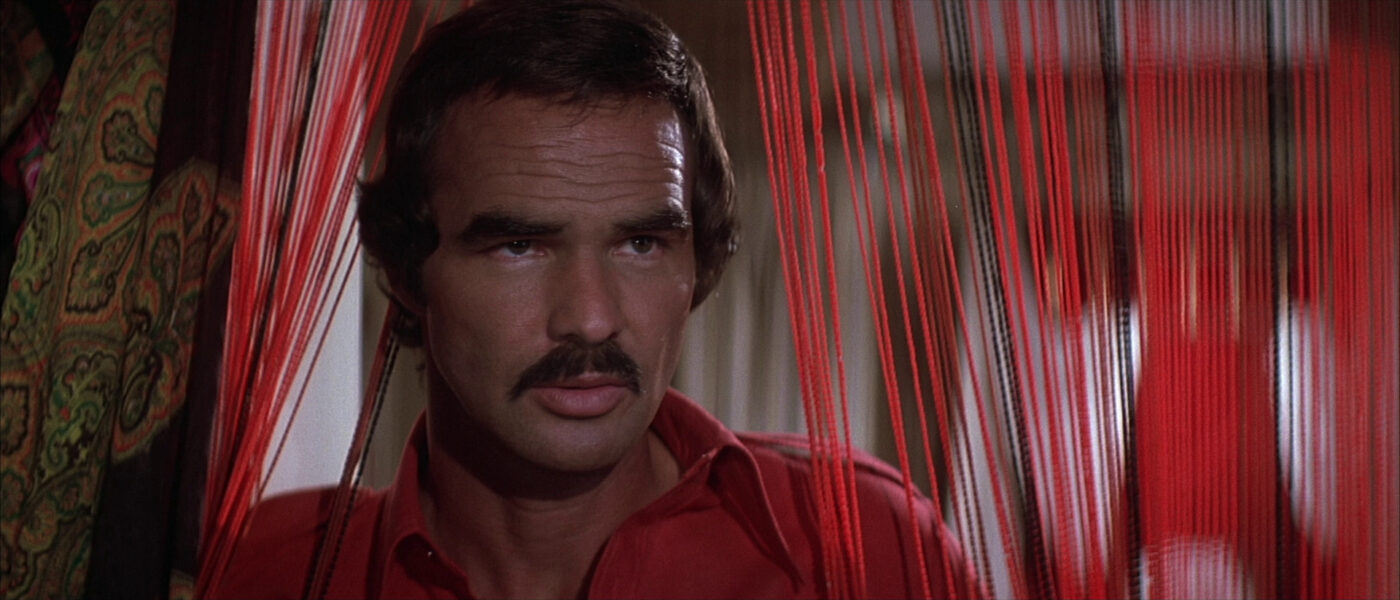Burt Reynolds Emerges Fully “Burt” As Moonshine Runner Gator McKluskey
DIRECTED BY JOSEPH SARGENT (WL) & BURT REYNOLDS (G)
STREET DATE: NOVEMBER 21, 2023/KINO LORBER STUDIO CLASSICS
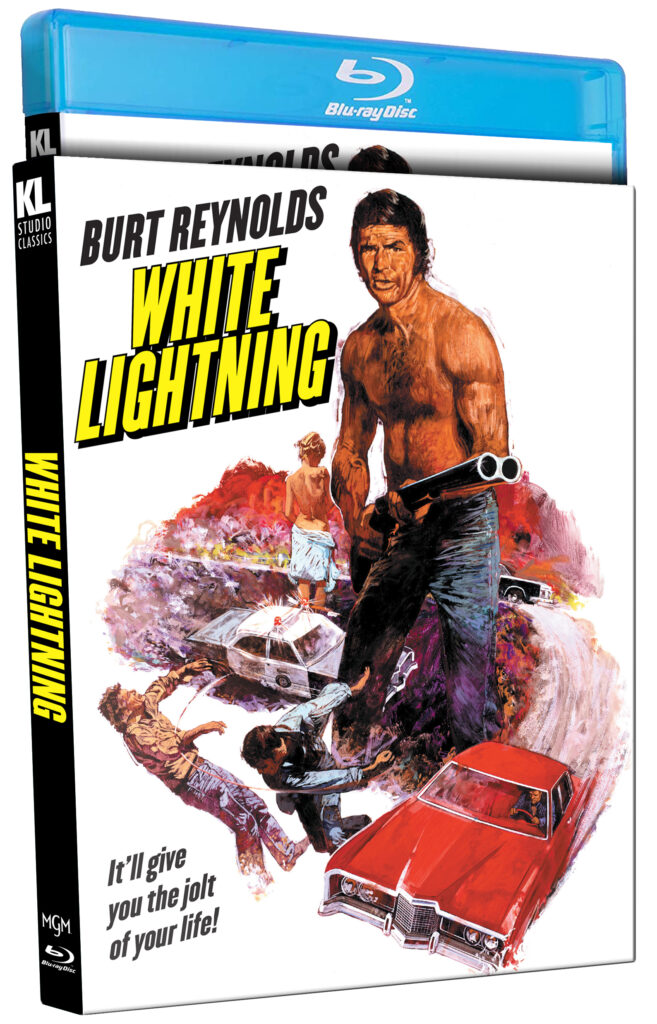
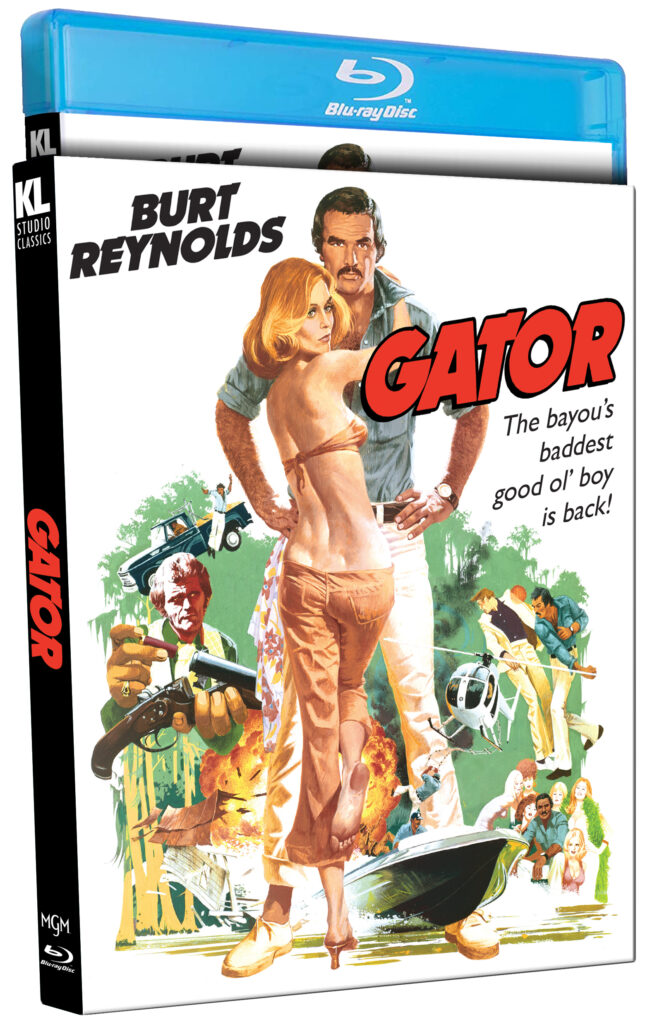
Burt Reynolds appears both with and without his iconic mustache in White Lightning (1973) and its sequel Gator (1976), his Southern outlaw Gator McKluskey gradually emerging wholly Burt-like across two popular mid-70s actioners. Muscle cars, grisly fights, and authentic location-shooting round out the considerable pleasures of these otherwise Burt-centric films, their inherently grainy look and definitively drive-in feel providing strong vehicles for eye-popping stuntwork, hard-edged realism, and under the Mason-Dixon line scenery. While most readily recognized today for composer Charles Bernstein’s brooding musical themes, sampled by White Lightning fan Quentin Tarantino in both Kill Bill, Volume I (2003) and Inglourious Basterds (2009), or subsequently as the title character of FX/FXX’s animated spy-parody Archer’s (2009-present) favorite and oft-confused films, White Lightning and Gator play today like particularly vivid postcards from another era, whose film-to-film progression may remind viewers today why Burt Reynolds was a top box-office draw in the years immediately following these souped-up and custom-made movie ramblers. Two new Blu-ray issues from Kino Lorber Studio Classics give a solidly tuned-up presentation to Reynolds’ Southern-set screen adventures as rascally rebel and good ol’ boy Gator McKluskey.
White Lightning (1973)
Dir. Joseph Sargent
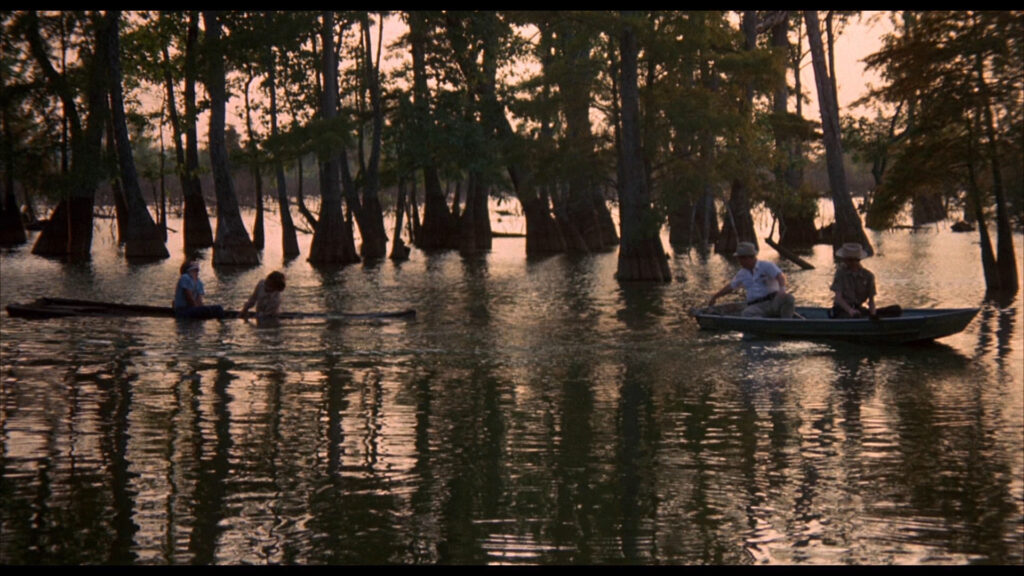
Edward Rosson’s twilit-burnt cinematography credit-opens with Bogan County sheriff JC Connors (Ned Beatty) and his deputy (Conlan Carter) rowing out on a separate skiff to the middle of a swamp, where two young, long-haired males struggle bound-and-gagged; the sheriff blowing out the bottom of their boat with an echoing shotgun blast. As we soon learn, one of the boys was the younger brother of one Gator McKluskey (Reynolds), who is currently doing five years in the state’s federal penitentiary for moonshine running. Unsuccessfully attempting to break out of prison in order to avenge his brother, Gator cuts a deal with the prison warden (Lincoln Demyn) to commute his sentence by getting the goods on the corrupt Bogan County sheriff.
Insinuating himself through turncoat mechanic Dude Watson (Matt Clark) into Sheriff Connors’ tax-evading moonshine operation, Gator makes good with runner Ray Boone (Bo Hopkins), Boone’s girlfriend, Lou (Jennifer Billingsley), and eventually, if uneasily, with distiller Big Bear (R.G. Armstrong), before ultimately arousing the suspicions of the wily sheriff. Time running out, along with presumably copious gallons of gas burning through these low-mileage vehicles, Gator may yet succeed in leading Sheriff JC on down the final road and out towards the swampy riverbed where it all began.
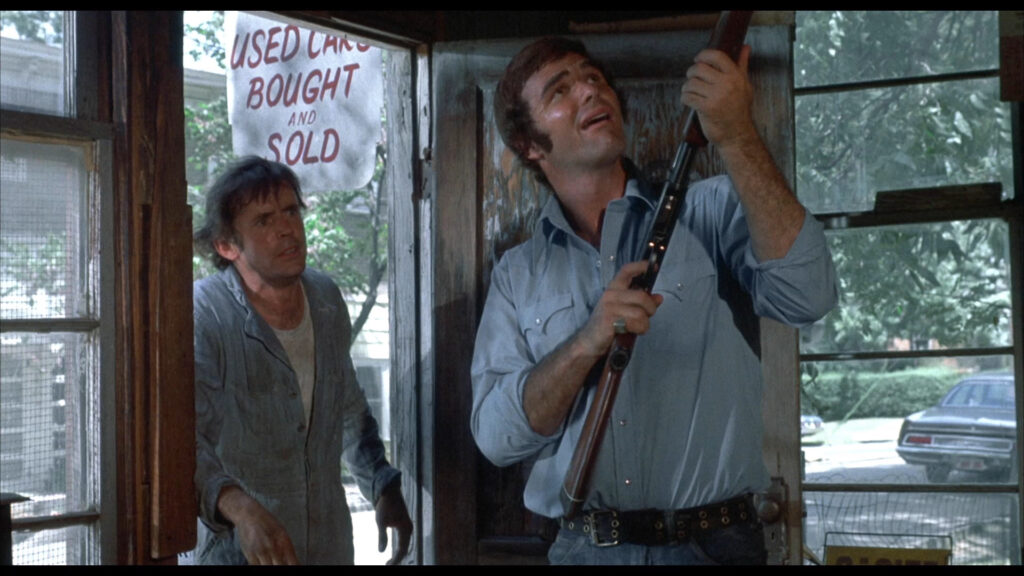
Scuzzy neo-noir in a sunbaked, southern setting, White Lightning was filmed in Arkansas during a heatwave, with locals and well-cast character-types populating the gray-green town-centers and dusty backroads, remaining one of the more authentic-looking location-shot films of its era. Sweaty to the point of many viewers being able to feel the heat, or even smell the body odors, the dirt-track stock-car yard or the tobacco and beef jerky displays of the local five-and-dime, or indeed the auto bric-a-brac lining the oily walls of Dude Watson’s repair shop, make White Lightning throughout – and beyond to the brown-burnt grass, roiling, muddy rivers, and twisty-turny county highways – one of the more realistically lived-in movies undoubtedly best experienced at the local drive-in.
While one might credit the pictorial realism first to director Joseph Sargent (The Taking of Pelham One Two Three [1974]), working closely with cinematographer Rosson to really capture that grit-and-grime look, and secondly to Southern-born star Reynolds for undoubtedly advocating both local color and authenticity, the excitement and energy of the production undoubtedly belongs to the second-unit direction and stuntwork supervised and performed by Reynolds’ career-length associate Hal Needham. Every engine rev, fishtail, and exhaust fume breathing authenticity, White Lightning really opens up when careening down these snake-swirling backroads, and the real sense of speed and danger was apparently nearly too realistic at times during shooting. (The film’s best remembered stunt, featuring Gators souped-up beige bruiser outrunning the sheriff’s deputies’ squad-car by a hundred-yard-leap across the river, to a thudding crash-land on the edge of a speeding corn barge, nearly brought stunt driver Needham to “a closer acquaintance with the grim reaper” than he had carefully planned or anticipated.) Along with the at times almost achingly realistic performance from Jennifer Billingsley as Gator’s love-interest, Ned Beatty’s frighteningly banal performance as the almost casually cruel Sheriff Connors, and Burt’s own embryonic-laconic charm as moonrunner McKluskey, White Lightning again breathes realism while capturing the title-liquid in a bottle, playing its low-key energy at fully fuel-exhausting levels, and somehow projecting it all onto weathered, heat-warped screens.
Gator (1976)
Dir. Burt Reynolds
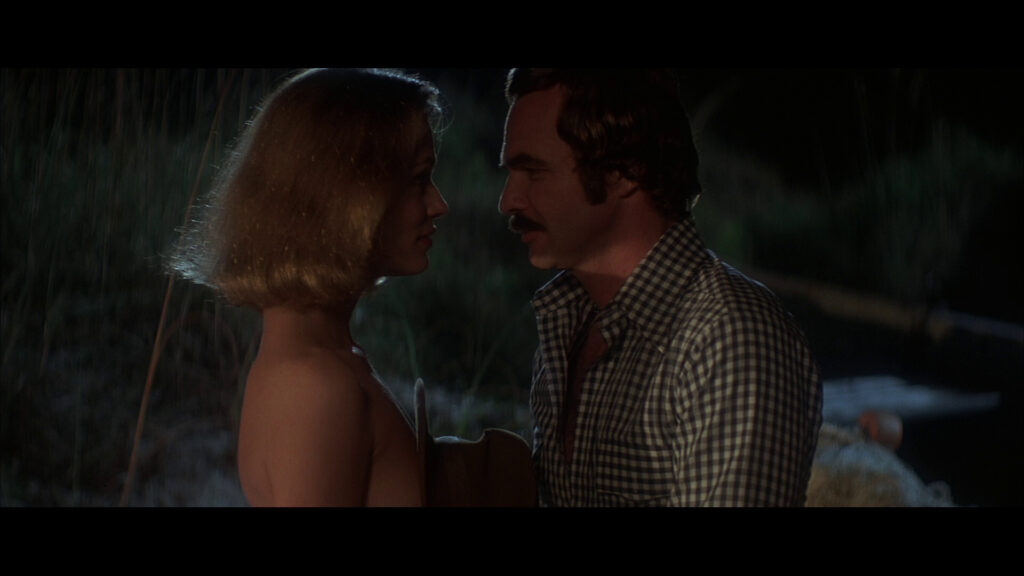
Defiantly opening with the Rebel flag flapping beneath the US one, in the first of several visual signals of America and the South approaching its Bicentennial year, New York-based FBI financial advisor to the US Attorney’s office Irving Greenfield (Jack Weston) puffs up the gleaming white stairs of the Georgia Capitol Building for a rotunda audience with the state governor (talk-show host Mike Douglas). Presenting the wary governor with a plan to clean up the dirty business of the state’s nationally-publicized region of crime and corruption, Dunston County, the scene switches to the edge of a swamp where Gator McKluskey (Reynolds), his aging father (John Steadman), and Gator’s nine-year-old daughter (Lori Fitch) have set up house – and, following his second term in prison, most recent moonshine operation – when Greenfield, a state-revenue helicopter, and a bevy of local and federal powerboats not-so-quietly approach Gators stylishly ramshackle shack from its vast, riverside “backyard”.
Following a jet-powered chase through the Georgia-swamp backwaters, Greenfield coerces Gator to once again cooperate with the federal government in reacquainting himself with childhood pal Bama McCall (Jerry Reed), who now runs a criminal enterprise of drugs, prostitution, and “protection” in Dunston County from its city-center. Reporting to comically out of his element Greenfield, and later teaming up professionally and romantically with TV investigative reporter Aggie Maybank (Lauren Hutton), Gator certainly gets the goods on Bama, but not before his dangerous friend retaliates in destructive and murderous kind on Gator and Gator’s associates. Building to an oceanfront confrontation between Gator and Bama, preceded by a near-fatal land-cruiser leap from a giant dune, the boys wreak fist-throwing, body-heaving havoc on the vendor huts lining the beach before one literally brings the final shutter down on the other.
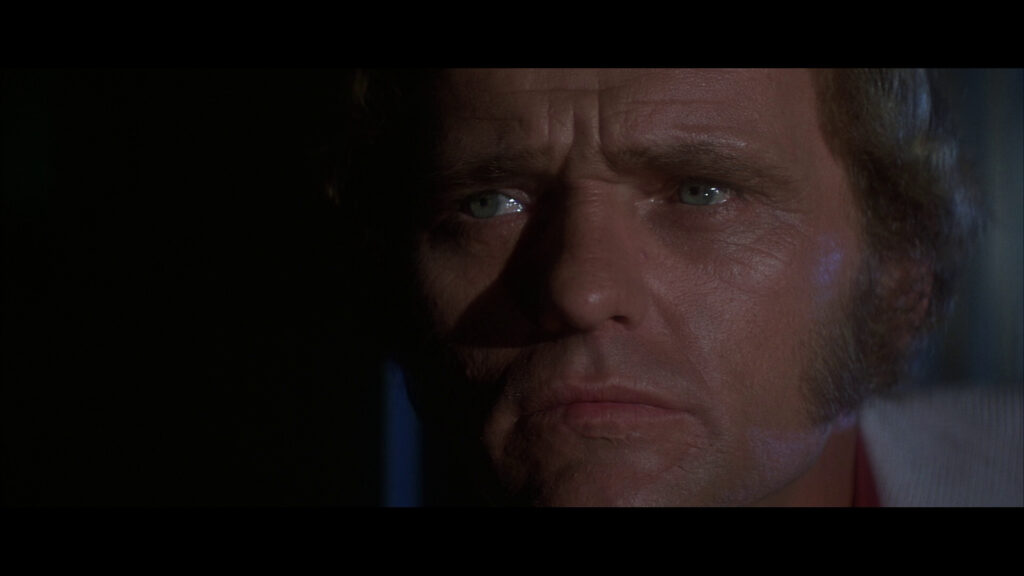
Prolific screenwriter William Norton returns, along with composer Charles Bernstein and a more prominently-credited Hal Needham, for the sequel to White Lightning of three years before, which is otherwise as unlike the previous film as a bushel of Georgia peaches is to a barrel of Arkansas rotgut. Reynolds takes the directorial reins for his successful debut, the location-shot move from Arkansas to Georgia signified first by cinematographer William A. Fraker’s stunning widescreen images, Reynolds the first-time director opting for a classically-composed and carefully-lit style, a stark difference to the sunbaked, naturalistic look and feel of its predecessor, and second, more noticeably, by the sequel’s decidedly lighter, and at times outright comic, tone. The revenge plot overtaken by a more complicated crime melodrama and ridealong romance, Gator with its strong local color, one of the first films to benefit from Georgia’s famed filming program, and even stronger character types, including Weston, Burton Gilliam, Dub Taylor, Alice Ghostley, John Steadman, and numerous locals and non-professionals, the production’s overriding concern and indeed raison d’être, is first and foremost as a showcase for Burt as Burt.
And such, individual mileage may vary, but the powerboats, helicopters and land cruisers, even beyond the muscle cars of the previous installment, finds full star-level expression in Burt’s triumphantly restored mustache, his Gator of some years later having appeared to have similarly grown a considerable sense of humor in the interim, that would not be out of place, say, on the mid-afternoon couch of TV’s Mike Douglas (who indeed, as mentioned, makes an impressive cameo as the distinctly un-Jimmy Carter-like state governor). Pulling back the expected quips, horse laughs, and winking assides of Burt going full Burt, however, is Gator’s other central performance from third-lead Jerry Reed, whose Bama McCall is almost an evil parody of the Burt Persona. Like Gator’s shadow self, Bama is as charming, smiling, and joking as his old pal, but can turn deadly on a dime, his double shotgun-shelled hand-cannon and snake-like powers of manipulation as equally frightening as Gator’s brave recklessness is ultimately heroic. While not quite matching the audience-involving follow-through of revenge-fueled roadsters from White Lightning, the confrontation between an almost super-humanly charming comic hero and a more deadly and equally charming villain, superbly played by Jerry Reed, finds Gator similarly struggling between broader comedy and deadly serious tragedy. Fascinating to the right viewer, however, this conventionally prettier-looking, more comic, and entertainment-driven sequel, with Hal Needham’s crash-landing off the beach dune or Reed in-frame shooting out the tire of a squealing gas-guzzler captured for all posterity, nevertheless leaves nagging doubts over precisely where Bama ends and where Gator begins. (Frankly, one’s eyes would be drawn equally to both good ol’ boys in a crowd. In this case, though, the mustache signals the good guy.)
…
In addition to the superior visual resolution of Kino Lorber’s Blu-ray reissues, which comes packaged with slipcovers on both films and reversible cover images for White Lightning, both discs contain TV spots and trailers relevant to other KL Burt Reynolds releases, and two interviews with the man himself, conducted in 2014, titled Back to the Bayou: Part I and Part II, carried over from KL’s earlier releases. But the otherwise most profound and valuable selling-point of these new special editions is undoubtedly a pair of more recently-recorded commentaries from Steve Mitchell and Nathaniel Thompson.
Knowledgeable and engaging throughout, Thompson and Mitchell not only keep up with the action on screen, mutually marveling at the hair-raising stunts, practical effects, and palpable atmosphere, but also manage to expertly delineate production details and contemporary reactions in a broader view of mid-seventies cinema and Burt’s unique place within it. Mitchell, a native New Yorker, and Thompson, a Georgia southerner, bring their diverse perspectives to bear on Burt’s emergence as a top box office draw between 1978 and 1982, of which his Gator McKluskey films provide a clear leading car-leap to Burt and stuntman-turned-director Hal Needham’s breakout success of the very next year, Smokey and the Bandit (1977). Both unmistakably prefer the grit and realism of White Lightning to the comparative schizophrenic sheen of Gator, but as a doubling, down-’n-dirty dry-run for Burt and Needham’s later Hooper (1978) and Cannonball Run (1981) films, with Burt’s own Atlanta-shot Sharky’s Machine (1981) an overlooked return to the grime and grit, Thompson and Mitchell make clear just how strongly Reynolds dominated this era of entertainment, solidified by his numerous talk show appearances.
I believe it’s Mitchell who muses during a scene in Gator where Bama has drugged Gator’s drink, and an initially harrowing, tense confrontation between the two adversaries veers uncomfortably into Burt playing a comic drunk, whether the appeal and star power would remain evident to new or newer viewers unfamiliar with Burt’s more serious, earlier roles. It’s an interesting question, and one I didn’t have an immediate answer for in revisiting these very different films, where Burt is nevertheless playing the same character, albeit similar in name only.

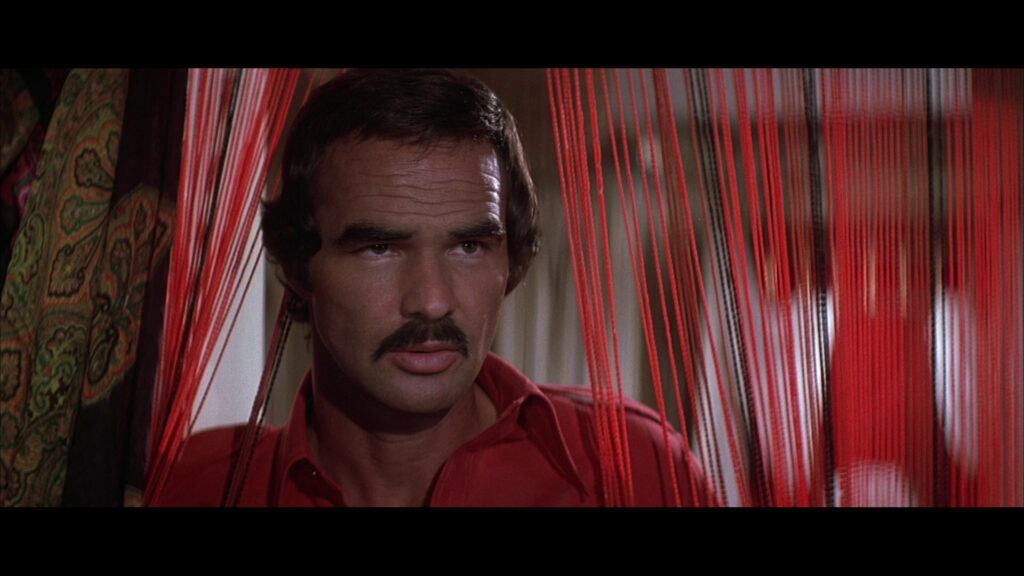
As a sign-off on that question, I’ll merely make the observation to the yet initiated that there are two types of Burt roles: ones where he wears a mustache and ones where he does not. As the line of demarcation between the two Burts seems to be stretched precisely across the midpoint of the 1970s, White Lightning (1973) and Gator (1976) remain the ideal vehicles to experience the better qualities of both.
Images used in this review are credited to the good folks at DVDBeaver. Images from White Lightning are captured from Kino Lorber’s previous Blu-ray release of 2014, which do not necessarily reflect the quality of their most recent release, while images from Gator are captured directly from the November 2023 special edition Blu-ray.


